 MRP Starting Stock in Sage X3
MRP Starting Stock in Sage X3

The calculation of MRP starting stock – the quantity of the product in stock at the start of the MRP process – differs depending on whether the product is non-versioned, versioned, or project related.
In this blog, originally posted on Sage City Community by Shawna Lapp in April 2020, we will review how Sage X3 calculates starting stock for each.
The available stock is:
- initialized to the quantity of stock available at the start of the MRP process (starting stock)
- increased by the incoming supply (i.e., work orders, purchase orders, etc., throughout the MRP process)
- decreased by the outgoing demands (i.e., sales orders, material requirements, safety stock requirements, etc., throughout the MRP process)
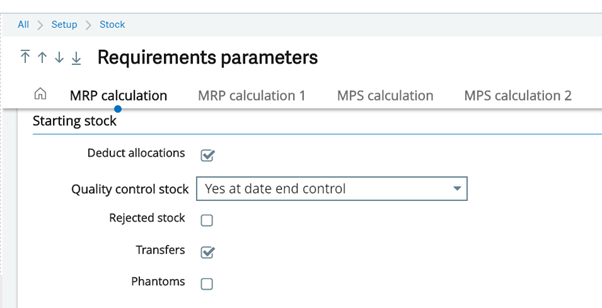
The MRP process covers a period of time. This time period is divided into ‘buckets’ (these can be days, weeks, and/or months). If the available stock falls below zero by the end of each bucket (i.e., the demands outstrip the supply), then a suggestion is generated in order to make up the shortfall.
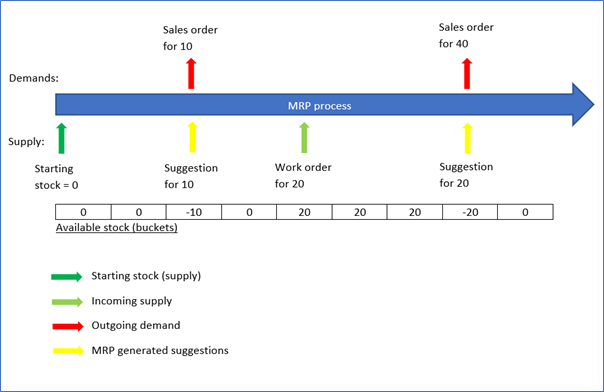
In the diagram above, the starting stock = 0 (i.e., there is zero quantity of the product in stock at the start of the MRP process).
In the diagram below, the starting stock = 15 (i.e., there are 15 units of the product in stock at the start of the MRP process).
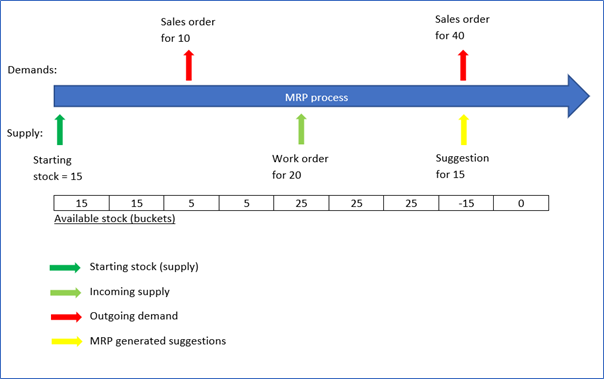
Non-versioned product
The value of starting stock is built according to particular requirement parameters. These parameters are “Deduct allocations”, “Rejected stock”, and “Quality control stock” (all found under Starting stock).

This refers to physical stock (not Rejected or under Quality Control). If enabled, then starting stock incorporates the following quantities (taken from the table Product-site totals – visible to the user via the Product-site Stock tab):
Dock ‘A’
Subcon ‘A
Global allocated
Alloc. subcon. ‘A’

This refers to rejected stock. If enabled, then starting stock incorporates the following quantities (taken from the table Product-site totals – visible to the user via the Product-site Stock tab):
Dock ‘R’
Sub-con. stock ‘R’
Alloc. subcon. ‘R’
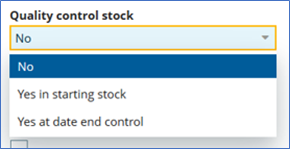
This refers to stock under quality control. If set to “Yes in starting stock”, then starting stock incorporates the following quantities (taken from the Product-site totals table – visible to the user via the Product-site Stock tab):
Dock ‘Q’
Subcon. ‘Q’
Alloc. subcon. ‘Q’
If set to “Yes at date end control”, then starting stock is determined as follows (quantities taken from the Stock table where the status is ‘Q’).
- If there is no Quality analysis request or the Quality analysis request end date <= MRP start date, then add/subtract the following Stock quantities:
Act qty in process
- If there is a Quality analysis request and its end date <= MRP end date and > MRP start date, then generate a ‘supply’ transaction (MRP working table – along with all other supply and demand transactions) with a date corresponding to the end date of the Quality analysis request (i.e., when this stock passes QA, and becomes active, then it can be used in MRP at that point.) See the diagram below.
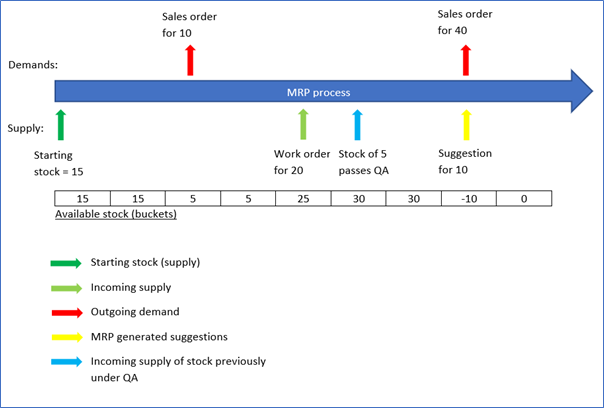
Versioned product
MRP treats versioned product versions as distinct products. Every incoming supply and outgoing demand must reference a particular product version (a sales order, for example, that has no product version specified is assigned a version by MRP).
Similarly starting stock is calculated for each product version as follows:
For each product version where Flow = Stock, and Status = Active, link the Versions table and
the Major version statuses table.
For each stock entry where Location category <> Customer (i.e., not on Loan), link the Stock table and the Lot numbers table – versions are associated with lots.
If any of the following rules are met then add Active quantity STK and subtract Total allocated STK:
Stock status = ‘A’
Stock status = ‘R’ and Rejected stock is þ
Stock status = ‘Q’ and Quality control stock is Yes in starting stock
Stock status = ‘Q’ and Quality control stock is Yes at date end control and there is no Quality analysis request or the Quality analysis request end date <= MRP start date
Otherwise, if the stock status = ‘Q’, and Quality control stock is ‘Yes at date end control’, and there is a Quality analysis request and its end date <= MRP end date and > MRP start date, then generate a ‘supply’ transaction (MRP working table – along with all other supply and demand transactions) with a date corresponding to the end date of the Quality analysis request (i.e., when this stock passes QA, and becomes active, then it can be used in MRP at that point.) See the diagram below.
Project related
Supply and demands for a particular product/project are processed separately by MRP.

Starting stock must also be calculated (and applied) per project as follows:
Determine the projects from all the supply and demands to be processed.
For each project (process project related stock):
- Calculate the available project related starting stock (quantities taken from the Stock table)
- If any of the following rules are met then add Active quantity STK and subtract:
- Cumulative quantity allocated
- Stock status = ‘A’
- Stock status = ‘R’ and Rejected stock is checked
- Stock status = ‘Q’ and Quality control stock is Yes in starting stock
Note: this applies to both versioned and non-versioned products.
Note: the allocations recorded in the Stock table are for Detail allocations only.
- Apportion the available project related starting stock across this project’s demands beginning with the earliest. This available starting stock offsets the demand’s requirement when processed by MRP.
Process non-project related stock:
- Calculate the available non-project related starting stock – similar to (1) above.
- Any global allocations are also applied here reducing the available non-project related starting stock
- Apportion the available non-project related starting stock across all demands (project and non-project) – if the “Stock for project” flag is enabled (Product-site > Planning); and across non-project related demands – if the “Stock for project” flag is not enabled.




